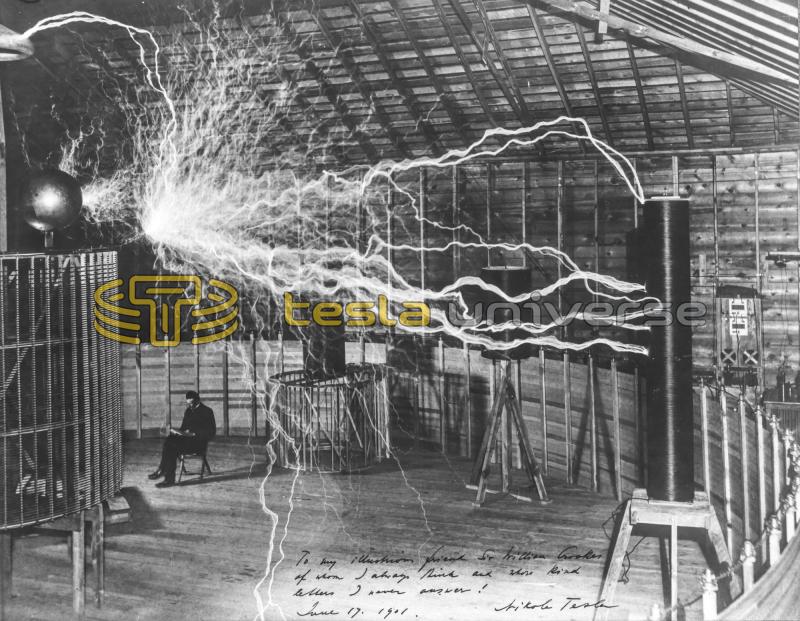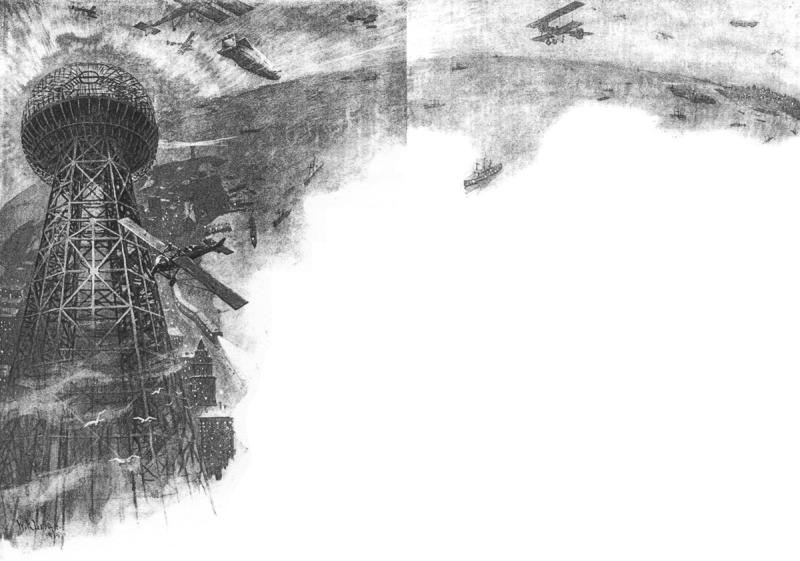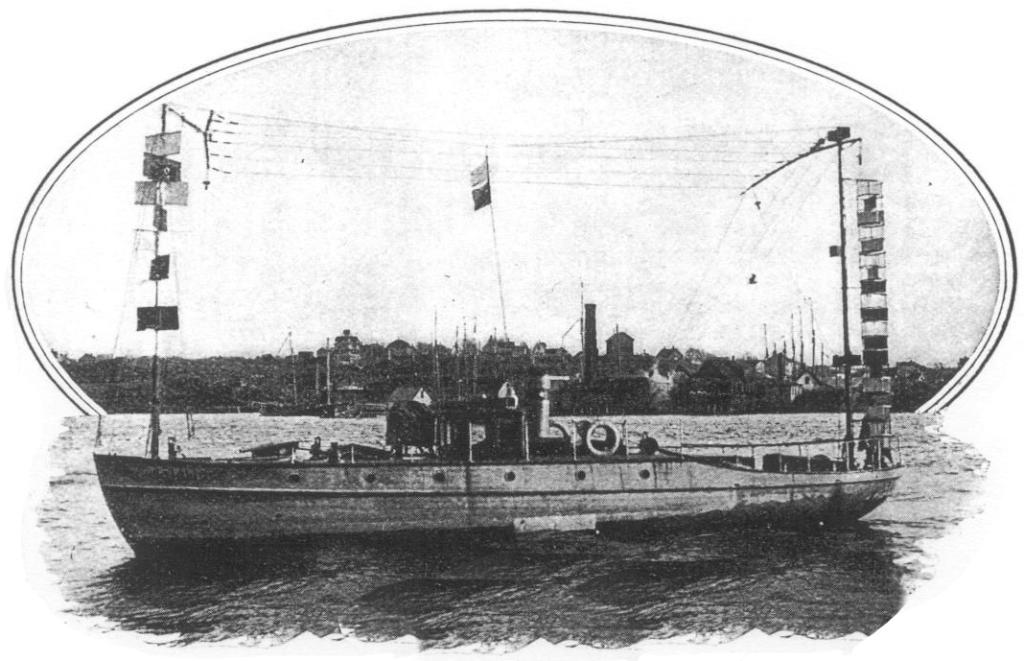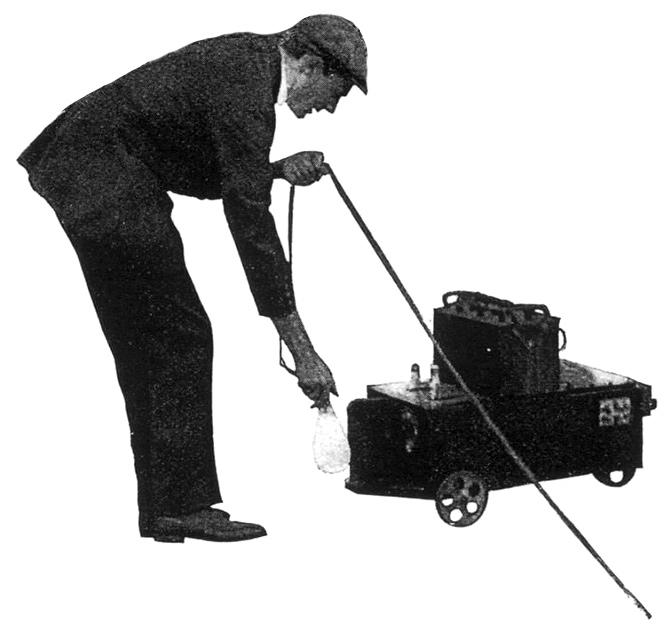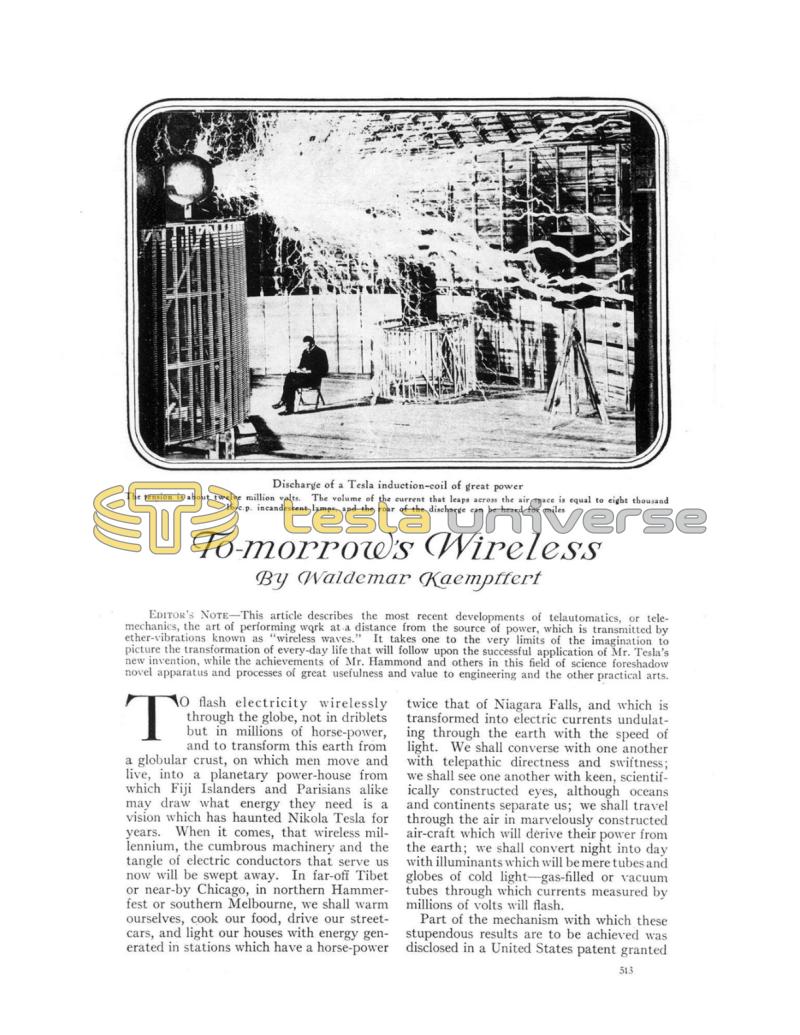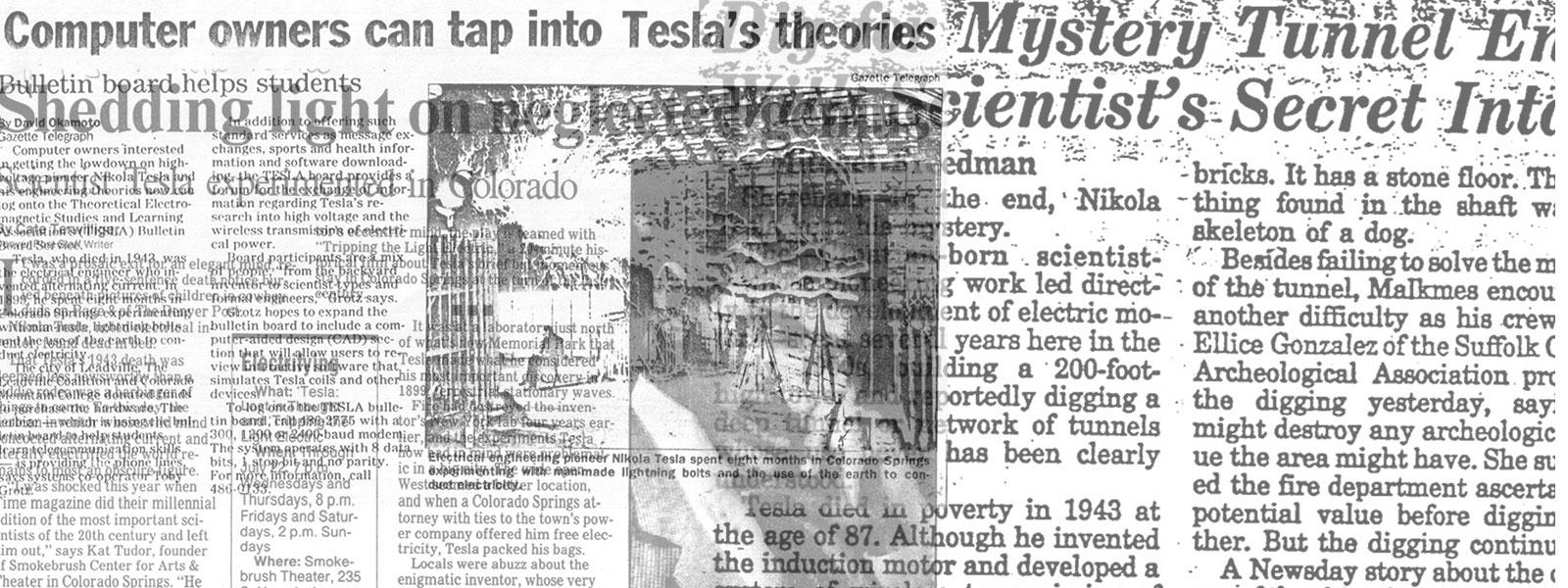
Nikola Tesla Articles
Tomorrow's Wireless
The tension is about twelve million volts. The volume of the current that leaps across the air space is equal to eight thousand 16-c.p. incandescent lamps, and the roar of the discharge can be heard for miles
EDITOR'S NOTE - This article describes the most recent developments of telautomatics, or telemechanics, the art of performing work at a distance from the source of power, which is transmitted by ether-vibrations known as "wireless waves." It takes one to the very limits of the imagination to picture the transformation of every-day life that will follow upon the successful application of Mr. Tesla's new invention, while the achievements of Mr. Hammond and others in this field of science foreshadow novel apparatus and processes of great usefulness and value to engineering and the other practical arts.
To flash electricity wirelessly through the globe, not in driblets but in millions of horse-power, and to transform this earth from a globular crust, on which men move and live, into a planetary power-house from which Fiji Islanders and Parisians alike may draw what energy they need is a vision which has haunted Nikola Tesla for years. When it comes, that wireless millennium, the cumbrous machinery and the tangle of electric conductors that serve us now will be swept away. In far-off Tibet or near-by Chicago, in northern Hammerfest or southern Melbourne, we shall warm ourselves, cook our food, drive our streetcars, and light our houses with energy generated in stations which have a horse-power twice that of Niagara Falls, and which is transformed into electric currents undulating through the earth with the speed of light. We shall converse with one another with telepathic directness and swiftness; we shall see one another with keen, scientifically constructed eyes, although oceans and continents separate us; we shall travel through the air in marvelously constructed air-craft which will derive their power from the earth; we shall convert night into day with illuminants which will be mere tubes and globes of cold light-gas-filled or vacuum tubes through which currents measured by millions of volts will flash.
Part of the mechanism with which these stupendous results are to be achieved was disclosed in a United States patent granted to Tesla on December 1, 1914. That patent bears the simple title, "Apparatus for Transmitting Electrical Energy.' To the government officials who granted it and to the university physicist who troubled to read it, the document must have seemed like many another of its kind. Yet this "apparatus for transmitting electrical energy" is the principal element in a whole system of artifices which, when developed to their fullest possibilities, will make electricity as essential in our lives as the air we breathe.
To understand this transformation of the future, we must begin with wireless telegraphy not because it bears any similarity to the principles which Tesla seeks to apply but because it is so different.
Throw a pebble into a pool of water. Little waves will ripple out in ever-widening circles and finally die away. An electric spark - a miniature artificial flash of lightning - sends forth similar ever-widening electrical waves at the tremendous velocity of one hundred and eighty-six thousand miles a second. Because our retinas are not constituted to see these waves, we must use a specially designed artificial eye. Every wireless telegraphic-receiving station contains such an eye to visualize the Morse signals flashed by the electric spark in the transmitting station.
Because electrical waves represent energy, not a few inventors have tried to use them for other purposes than flashing the dots and dashes of the Morse code. Probably the most conspicuous of these men is John Hays Hammond, Junior, whose crewless, wirelessly directed boat and electric "dog" have attracted much attention. Although he is not the first in the field, he has progressed far in what has been called "telautomatics" and "telemechanics." His unmanned boat proceeds in the direction wirelessly willed by the operator on land with a precision that is uncanny, and his "dog" is far more obedient to the electric waves which he sends out than the average domestic bull pup to his master's call. Others who have experimented in this field are Branly, a wireless pioneer, who has succeeded in firing guns, starting and stopping machine-tools, controlling clocks, and lifting heavy weights with the aid of electric waves; Knudsen, who has made some imperfectly successful attempts to transmit pictures by wireless, and Hirth, who is working along the same lines as Hammond.
But all this is scarcely a world-wide distribution of power. Without exception, these inventors are dealing with wireless signals. The waves sent out from their transmitters are not directly utilized to run a motor or light a lamp but to control electrical machinery with which we are all familiar. In crewless submarine boats, in picture-recording apparatus wirelessly operated, we find, in the receiving station, all the mechanism that we now install in boats or telegraph stations. The waves simply act on a delicate receiver, and thus open and close an electric circuit. They take the place of the human hand in throwing a switch - nothing more.
In a large sense, all these men are sending energy without wires through space. But what a wasteful method-wonderful as it is! Of all the energy rippling out from the transmitting spark, not one part in one hundred million parts reaches the particular receiver to be affected. When the key of the transmitter is depressed, as much as fifty horse-power must be projected into space in order that an infinitesimal part of it may be feebly detected as a signal by an instrument three thousand miles away.
Other wastes, too, must be reckoned with by the designer of wireless-telegraph apparatus besides the waste in electric waves. When a powerful spark is to be employed for long-distance signaling, there is a leakage of current which it is impossible to control. Besides, every building, every obstacle on the face of the earth absorb part of the energy sent forth.
If there were only some way of sending this energy into the earth, of directing it from South Africa to Buenos Aires, there to be tapped off and utilized, what a saving there would be! But waves of a different kind would have to be generated-how, is partially told in the patent that has now been granted to Tesla after years of waiting and laboring.
If you would understand, in a general way, the manner of realizing this amazing possibility, you must understand the full meaning of resonance. Begin with the swinging pendulum of your clock. What keeps it going? Nothing but a little push mechanically delivered at the right time. Any freely swinging object can be kept in motion, even though it weigh tons, if it is given the slightest push by a single finger, but always at the right moment. Indeed, the amount of swing can be increased enormously by successive pushes correctly timed.
Everything in the world has a natural period of vibration. A hundred men can capsize a twenty-thousand-ton battle-ship by running rhythmically from one side of the deck to the other and carefully timing their movements to the frequency of rolling. If the natural period of a fifty-story skyscraper's vibration were known, a boy with a tack-hammer might shake down the entire structure by persistent tapping at correct intervals. Such is the cumulative effect of many little blows.
This principle of timing small impulses so as to produce large effects is the principle of resonance. When you rub the rim of a wine glass with your finger and make it ring with a clear musical note, you apply it in producing sound-waves. You can also apply it in producing electrical waves, and that is what Tesla has done.
Tesla's Great Invention
Sixteen years ago, while conducting some experiments in the high altitude of Colorado, Tesla found that the entire earth is electrically resonant to certain vibrations. Suppose it were possible to construct an apparatus which would set up electrical waves in the earth, with an apparatus which would be the electrical equivalent of the boy's tack-hammer that could throw down the monster sky-scraper; suppose that it were possible to pile electric impulse on electric impulse until the accumulation of them all would represent millions of horsepower in electric oscillations; suppose that you had a way of turning a tiny part of that unthinkable amount of power into a motor to run a street-car, light electric lamps, and perform other useful work; suppose that you could impress the faint modulations of your voice upon the electrically vibrating globe-surely that would be the millennium of electricity; surely that would be the most stupendous achievement in the annals of engineering. Yet that dry, uncommunicative patent granted to Tesla discloses a means of setting up the waves to which the earth is electrically resonant.
Preliminary experiments have been made which convince Tesla that power can be wirelessly transmitted through the earth. They have enabled him, so he assures us, to light electric lamps at short distances without any metallic conductor between them and the source of power. So far cheaper will this system be that, even if it were only one per cent. efficient, it would deserve every encouragement.
But the designing of an apparatus for emitting waves to which the earth is electrically responsive is only a part of the inventor's task. He must transmit his energy without loss to the point where it is wanted, which he claims is feasible. He must invent some way of individualizing the energy intended for you and for mesome way, for example, of confining a telephone conversation between New York and Peking to the speaker and his listener. In that, too, he has made progress. Strike a tuning-fork, so that it vibrates and emits a musical note, bring that vibrating fork near a piano, and you will find that of all the strings in the piano just one will sing in sympathy. A similar but much more elaborate system, a combination of sympathetic receivers, must be employed. Spencer's clear and suggestive exposition of the human nerve-mechanism gave him "the fundamental idea of employing a number of distinctive elements, cooperatively associated for the purpose of isolating the energy transmitted," Tesla states.
A New Vision of the Future
It will be a marvelously different globe from that which we know if Tesla's vision is realized. As a wine-glass vibrates with sound when its rim is rubbed, so the earth will vibrate electrically when it is subjected to the action of millions of impulses correctly timed. And those impulses will be imparted by gigantic induction-coils incorporated in immense, towering steel cages, each not unlike the steel skeleton of a huge office-building in course of construction. In every large city, you will see such a steel frame, projecting far up into the sky, overtopping houses and buildings an electrically throbbing heart whose electric beat can be felt like a pulse in the uttermost confines of the earth. In each home, you will find cheap devices for utilizing what small portion of the power thus transmitted it may need. Wherever you will go, there you will witness a marvel of wireless engineering. In smokeless factory-towns, thousands of wheels will be turned - all with power taken from a conductor that runs into the ground. Canal-digging exploits will be performed compared with which the excavating of a waterway across the isthmuses of Suez and Panama will seem as slow as the picking of a granite wall with a needle-so limitless are the possibilities of designing machinery driven by earth-power. Farming will become as easy as gardening with the aid of mechanism so cheaply operated that less energy will be consumed in plowing an acre than is now required to operate a vacuum cleaner. Whatever we achieve but imperfectly with our present crude inventions, whether it be telephoning or transmitting pictures electrically, railroading or automobiling, housekeeping or mining, will be accomplished with wireless energy with a completeness and simplicity that will seem positively esthetic.
The greatness of an invention or an engineering project may often be measured by its sociological effect. It brings alien races closer together, which, in turn, means better propagation of knowledge. But what may not be expected when the new branch of electrical engineering that Tesla has created is fully developed, when every one of us will have as much and more power at his command as New York requires to propel trains through its subway? Electrically considered, the earth shrinks to a little ball on which Zulus and Frenchmen, Maoris and Russians, Patagonians and Eskimos are mere neighbors. A complete community of interest will prevail on the earth when his power-plants are installed, Tesla imagines, not because a distant extinction stares us in the face but because the globe will become a true Mother Earth - the source from which East, West, North, and South will derive the energy upon which harmonious existence depends.
